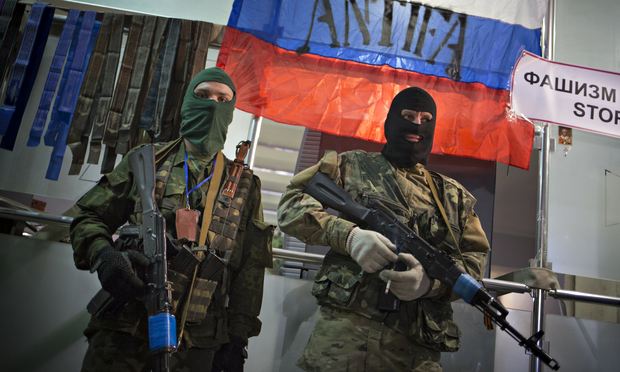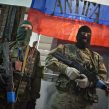
Armed Formations in the Secessionist ‘Luhansk Republic’ (Part One)
Publication: Eurasia Daily Monitor Volume: 12 Issue: 5
By:

The armistice in Ukraine’s east affords Russia a breathing pause to institutionalize the secessionist Luhansk and Donetsk “people’s republics.” The “Luhansk People’s Republic (LPR)” is even less institutionalized and more chaotic than the nearby Donetsk republic (“DPR”). Various armed formations in the “LPR” are operating, as a rule, uncoordinated with Luhansk authorities or with each other; and sometimes in rivalry with each other (see accompanying article).
Field commanders must, to a certain extent, take orders from their Russian sponsors and from Luhansk military authorities; but they tend to be recalcitrant and insubordinate toward the “LPR’s” political leadership. Moreover, the field commanders rule portions of the “LPR’s” territory de facto, in nominal and conditional allegiance to the center. This pattern is reminiscent in some ways of the feudal fragmentation of yore. More closely in time and place, the commanders’ modus operandi recalls the Makhnovshchina of almost one hundred years ago in this same territory (in the first several years after World War I, the highly decentralized Revolutionary Insurrectionist Anarchist Army militia controlled and operated in this area).
Turf protection is a salient characteristic of these armed formations. Based in the countryside, each of them clings to a well-defined territory, rarely venturing out from its locality or to Luhansk City. As a result, the “LPR’s” territory is divided into de facto bailiwicks, each with its own field commander and garrison. This pattern is not observed in the “DPR,” where political and military authority is more centralized and the territory more urbanized, compared with the “LPR.”
The territorial fragmentation and strong turf-orientation of these armed formations have significant consequences on the military level. Each “brigade” or “battalion” tends to fight mostly within in its own bailiwick against Ukrainian forces, whether on the defensive or by using long-range artillery offensively. These formations seldom conduct joint operations against Ukrainian forces. Nor do the field commanders bargain jointly with Luhansk political authorities.
In each of those bailiwicks, the field commander acts de facto as a local ruler, coexisting with the “LPR’s” local administrations and elected mayors, but overriding them in practice. The field commander can informally function as local judge, police chief (with self-arrogated powers to arrest), tax collector and requisition authority (“for war needs”), humanitarian aid distributor, and otherwise fill the vacuum of state power. These local rulers with their retinues can generate significant income by selling protection services to local industrial enterprises, marketing Luhansk coal, and skimming and reselling humanitarian aid consignments (Novosti DNR, January 2, 2015; Novorossiya News Agency, January 3, 5, 2015).
Most of these field commanders style themselves as Atamans, and their retinues as (Russian) Don Cossacks; but the claimed Cossack descent and status seems seldom authentic. In their telling, the Don Cossack Host (centered in Russia’s Rostov region) has historic land claims on the Luhansk area.
Russia delivers the arms and equipment to the Luhansk authorities, which redistribute some of that materiel to formations in the field. “LPR” authorities can leverage this redistribution mechanism to bring those freewheeling groups into Luhansk’s subordination, then to transfer them into the newly created Corps of People’s Militia (see accompanying article). The “LPR” authorities would like to reduce and ultimately break the field commanders’ power. The authorities’ preferred option is to enlist those fighters individually, rather than on a group basis. The “president,” Igor Plotnitsky, has recently offered enlistments through individual transfer, under threats of compulsory disarmament (Luganskyi Informatsionnyi Tsentr, December 24, 2014).
Plotnitsky’s interactions with these formations are tense and marked by mutual distrust. These detachments and their members generally felt disappointed by the September 2014 armistice agreements and the near-cessation of combat that took effect from December 9. The prevailing sentiment since then, as seen abundantly in Internet media, seems to be an impatient wish to continue hostilities against Ukraine. A few of those holding command ranks are apt to cite political motivations for engaging in this war. The rank-and-file’s motivations range from lack of prospects in civilian life to Russian nationalist or imperial indoctrination (of the neo-Tsarist, Soviet, and Putinist varieties) to sheer adventure-seeking and war comradeship.
Members of these formations sometimes claim to have been joined by volunteer fighters from European countries. The evidence of international participation, however, is confined to a small number of individual cases. The pretense is merely self-flattering. It makes these primitive local groups look somehow in tune with the outside world. Moscow also speaks of participation by international volunteers, so as to relativize Russia’s culpability for itself organizing the proxy war in Ukraine.
There is a powerful Russian social phenomenon behind the flow of volunteers to fight in Ukraine, potentially repeatable elsewhere. Russia, uniquely, is home to many hundreds of thousands of military veterans of fighting age, with combat experience from several wars, with unrewarding, often marginal civilian lives, easily mobile due to weak societal attachments, energized by the official propaganda, and disposed (as they have been over generations in Russia) for some liberation war abroad. This social phenomenon sets Russia starkly apart from European societies. It provides Russia’s leadership with a large manpower reservoir to tap into, and literally to inflict on potential target countries across the border. Of these, Ukraine has become the first actual target country, in the age of hybrid war that Russia has opened in Europe.




